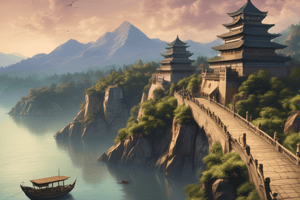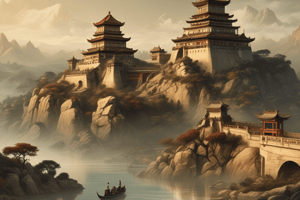Podcast
Questions and Answers
China, the third largest country in the world, encompasses diverse climates, from subarctic to ______.
China, the third largest country in the world, encompasses diverse climates, from subarctic to ______.
tropical
The Himalayan mountains are home to Mount ______, the tallest peak in the world.
The Himalayan mountains are home to Mount ______, the tallest peak in the world.
Everest
The Tibet Plateau covers one-fourth of China's landmass, with an average elevation of ______ feet above sea level.
The Tibet Plateau covers one-fourth of China's landmass, with an average elevation of ______ feet above sea level.
14,000
The Taklamakan Desert in northwest China experiences a cold desert climate with winter temperatures as low as ______ degrees Celsius.
The Taklamakan Desert in northwest China experiences a cold desert climate with winter temperatures as low as ______ degrees Celsius.
The Yellow River is ______ miles long and is named for the silt it carries.
The Yellow River is ______ miles long and is named for the silt it carries.
The Yangtze River, located south of the Yellow River, is the third longest river in the ______.
The Yangtze River, located south of the Yellow River, is the third longest river in the ______.
Ancient Chinese villages typically housed around ______ families each.
Ancient Chinese villages typically housed around ______ families each.
The need to transport supplies to soldiers guarding the northern Mongolian border led to the construction of the ______.
The need to transport supplies to soldiers guarding the northern Mongolian border led to the construction of the ______.
The ______ Desert is situated on the southern part of the Mongolian Plateau.
The ______ Desert is situated on the southern part of the Mongolian Plateau.
Oxen were primarily used for plowing, but the Chinese also trained ______ to assist with farmwork.
Oxen were primarily used for plowing, but the Chinese also trained ______ to assist with farmwork.
The earliest Chinese migrated to the Yellow River Valley from the north or northeast regions of China or ______.
The earliest Chinese migrated to the Yellow River Valley from the north or northeast regions of China or ______.
Chinese legends attribute fire-making, farming, and house-building skills to mythical ______.
Chinese legends attribute fire-making, farming, and house-building skills to mythical ______.
The Shang Dynasty is known for its culture of ______.
The Shang Dynasty is known for its culture of ______.
The Zhou Dynasty introduced a ______ system, where nobles paid professional warriors.
The Zhou Dynasty introduced a ______ system, where nobles paid professional warriors.
Frequent localized battles between nobles weakened China and caused ______ decline.
Frequent localized battles between nobles weakened China and caused ______ decline.
The Qin Dynasty emerged amidst conflicts and established the first ______ in northern China.
The Qin Dynasty emerged amidst conflicts and established the first ______ in northern China.
The Great Wall was constructed during the Qin Dynasty for defense against ______.
The Great Wall was constructed during the Qin Dynasty for defense against ______.
The Han Dynasty is renowned for marking a ______ age in Chinese history.
The Han Dynasty is renowned for marking a ______ age in Chinese history.
Advancements in science and technology during the Han Dynasty included ______-making.
Advancements in science and technology during the Han Dynasty included ______-making.
The Han Dynasty introduced nautical steering ______ for improved navigation.
The Han Dynasty introduced nautical steering ______ for improved navigation.
Flashcards
Tibet Plateau
Tibet Plateau
The largest plateau in the world, located in western China between the Himalayan and Kunlun mountains, with an average elevation of 14,000 feet.
Taklamakan Desert
Taklamakan Desert
A vast desert in northwest China characterized by cold desert climate with winter temperatures reaching -4 degrees Celsius.
Mongolian Plateau
Mongolian Plateau
A plateau that extends into China along parts of their border, spanning 1,200,000 square miles.
Gobi Desert
Gobi Desert
Signup and view all the flashcards
Yangtze River
Yangtze River
Signup and view all the flashcards
Yellow River
Yellow River
Signup and view all the flashcards
North China Plain
North China Plain
Signup and view all the flashcards
Hongo Canal
Hongo Canal
Signup and view all the flashcards
Grand Canal
Grand Canal
Signup and view all the flashcards
Ancient Chinese Villages
Ancient Chinese Villages
Signup and view all the flashcards
What is the Shang Dynasty famous for?
What is the Shang Dynasty famous for?
Signup and view all the flashcards
What is the defining feature of the Zhou Dynasty?
What is the defining feature of the Zhou Dynasty?
Signup and view all the flashcards
What significant changes did the Qin Dynasty bring to China?
What significant changes did the Qin Dynasty bring to China?
Signup and view all the flashcards
What is the Han Dynasty notable for?
What is the Han Dynasty notable for?
Signup and view all the flashcards
Where did early Chinese people migrate from?
Where did early Chinese people migrate from?
Signup and view all the flashcards
Who are credited in Chinese legends with developing key skills like fire-making, farming, and house-building?
Who are credited in Chinese legends with developing key skills like fire-making, farming, and house-building?
Signup and view all the flashcards
How did food surplus contribute to the rise of dynasties?
How did food surplus contribute to the rise of dynasties?
Signup and view all the flashcards
What is a feudal system?
What is a feudal system?
Signup and view all the flashcards
What was the purpose of the Great Wall in ancient China?
What was the purpose of the Great Wall in ancient China?
Signup and view all the flashcards
Why is the Han Dynasty called a golden age?
Why is the Han Dynasty called a golden age?
Signup and view all the flashcards
Study Notes
Geography of Ancient China
- China, the third largest country in the world, encompasses diverse climates, from subarctic to tropical.
- Its borders touch 14 countries, including India to the southwest, separated by the Himalayan mountains.
- The Himalayan mountains are home to Mount Everest, the tallest peak in the world, currently measured at 29,029 feet.
- The Tibet Plateau, nestled between the Himalayan and Kunlun mountains in the west, covers one-fourth of China's landmass, with an average elevation of 14,000 feet above sea level, making it the world's tallest plateau.
- The Taklamakan Desert in northwest China experiences a cold desert climate with winter temperatures plummeting to as low as -4 degrees Celsius.
- The Mongolian Plateau extends into China along parts of their border, spanning 1,200,000 square miles.
- Situated on the southern part of the Mongolian Plateau lies the Gobi Desert, featuring significant stops along the Silk Road during ancient times and the Middle Ages.
- Most of China's agricultural activities occur between the Yellow River and the Yangtze River, both originating from the Tibet Plateau and flowing into the North China Plain.
- The Yellow River, 2,900 miles long, is named for the silt it carries, which turns the water a yellowish color during floods.
- The Yangtze River, south of the Yellow River, is the third longest river in the world.
- Both major rivers flow east, emptying into the Yellow Sea, which connects to the Japanese Sea, providing diverse seafood resources for China's eastern shores.
- The rivers provided fertile land for farming, fish for food, and hemp for clothing, shaping the lives of ancient Chinese.
- Ancient Chinese villages, typically housing around 100 families each, were centered around farming.
- The first Chinese cities incorporated high walls of compacted dirt and gates that closed at night to protect their citizens.
- The need to transport supplies to soldiers guarding the northern Mongolian border and to facilitate faster communication across China prompted the construction of waterways, including the Grand Canal and smaller canals like the Hongo Canal.
- The Grand Canal, connecting northern and southern China, is well-known, while the Hongo Canal, built around 480 BC, predates it by almost 1,000 years.
- While oxen were used for plowing, the Chinese also trained dogs to assist with farmwork.
- Archaeological evidence suggests that the earliest Chinese migrated to the Yellow River Valley from the north or northeast regions of China or Mongolia.
- Chinese legends attribute fire-making, farming, and house-building skills to mythical Emperors.
- An increase in food surplus led to population growth, resulting in powerful families conquering weaker ones and establishing dynasties that shaped China's history.
- The Shang Dynasty, known for silk culture, ruled as a monarchy, producing bronze weapons, jade art, and a writing system.
- The Zhou Dynasty introduced a feudal system, where nobles paid professional warriors to protect them and pledged loyalty.
- Frequent localized battles between nobles weakened China and caused population decline.
- The Qin Dynasty emerged amidst these conflicts, unifying the government, establishing the first empire in northern China, improving trade with standardized weights and currency, introducing iron weapons and horse-drawn chariots for the army, and constructing the Great Wall as a defense against Mongolians.
- The Han Dynasty, renowned for its golden age, ruled for over four centuries, witnessing advancements in science and technology, including paper-making, nautical steering rudders, and seismometers for earthquake detection.
Key Dynasties in Ancient China
- Shang Dynasty
- Silk Culture
- Monarchy Rule
- Bronze Weapons and Jade Art
- Writing System
- Zhou Dynasty
- Feudal System
- Nobles Paid Professional Warriors
- Frequent Localized Battles
- Qin Dynasty
- Unified Government
- First Empire in Northern China
- Improved Trade with Standardized Weights and Currency
- Iron Weapons and Horse-Drawn Chariots
- Great Wall Construction
- Han Dynasty
- Golden Age in Chinese History
- Paper-Making
- Nautical Steering Rudders
- Seismometers
Studying That Suits You
Use AI to generate personalized quizzes and flashcards to suit your learning preferences.




